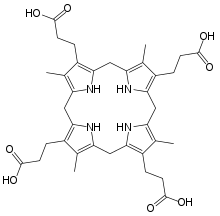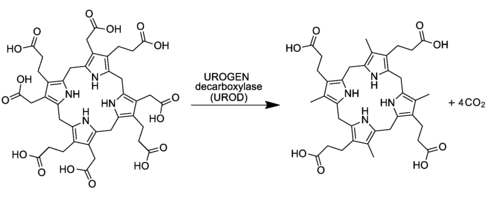Coproporphyrinogen I
Coproporphyrinogen I is an isomer of coproporphyrinogen III, a metabolic intermediate in the normal biosynthesis of heme. The compound is not normally produced by the human body; its production and accumulation causes a type of porphyria. [1]
 | |
| Names | |
|---|---|
| IUPAC name
3-[7,12,17-tris(2-carboxyethyl)-3,8,13,18-tetramethyl-5,10,15,20,21,22,
23,24-octahydroporphyrin-2-yl]propanoic acid | |
| Identifiers | |
3D model (JSmol) |
|
| ChemSpider | |
PubChem CID |
|
CompTox Dashboard (EPA) |
|
| |
| |
| Properties | |
| C36H44N4O8 | |
| Molar mass | 660.757 g/mol |
Except where otherwise noted, data are given for materials in their standard state (at 25 °C [77 °F], 100 kPa). | |
| Infobox references | |
The difference between coproporphyrinogen I and III is the arrangements of the four carboxyethyl ("P" groups) and the four methyl groups ("M" groups). The I isomer has the sequence MP-MP-MP-MP, whereas in the III isomer it is MP-MP-MP-PM, with the last two side chains reversed.
Biosynthesys
Coproporphyrinogen I is not produced in the normal porphyrin biosynthesis pathway. However, if the enzyme uroporphyrinogen-III cosynthaseis missing or inactive, the compound uroporphyrinogen I is produced instead of uroporphyrinogen III. The enzyme uroporphyrinogen III decarboxylase will also act on the I isomer, producing coproporphyrinogen I:[2][1]

The reaction entails the conversion of the four carboxymethyl (acetic acid) side chains to methyl groups, with release of four molecules of carbon dioxide.
Unlike the III isomer, coproporphyrinogen I (which is cytotoxic) is not further processed by the body, and accumulates. This situation occurs in the pathological condition called congenital erythropoietic porphyria.[1]
References
- S. Sassa and A. Kappas (2000): "Molecular aspects of the inherited porphyrias". Journal of Internal Medicine, volume 247, issue 2, pages 169-178. doi:10.1046/j.1365-2796.2000.00618.x
- Paul R. Ortiz de Montellano (2008). "Hemes in Biology". Wiley Encyclopedia of Chemical Biology. John Wiley & Sons. doi:10.1002/9780470048672.wecb221. ISBN 978-0470048672.